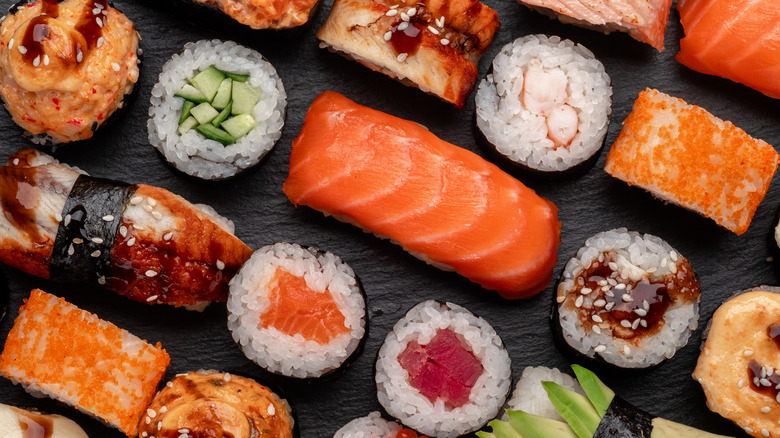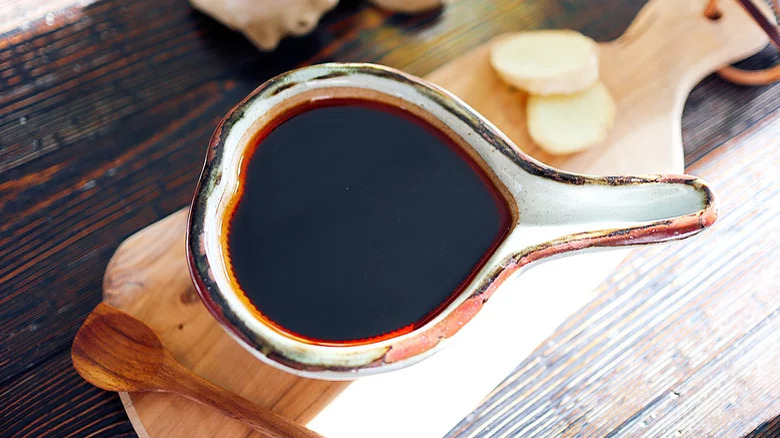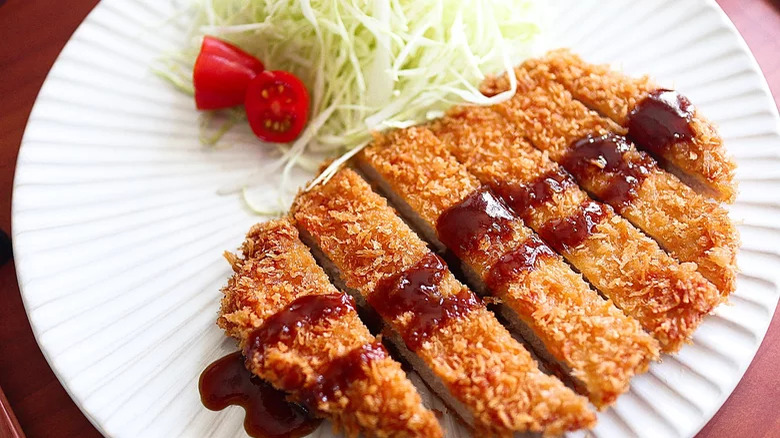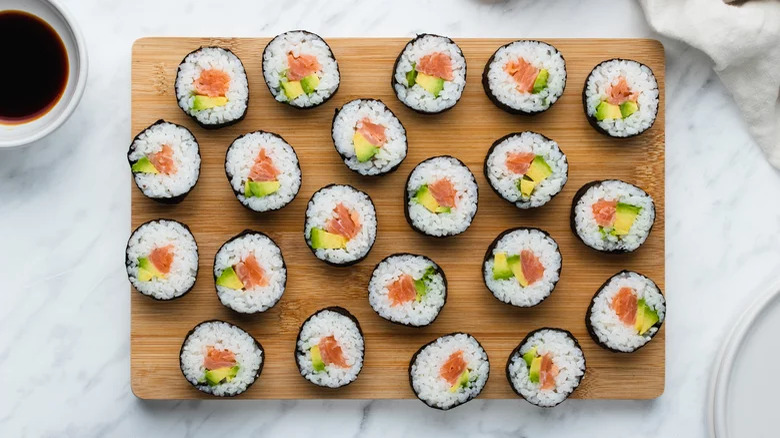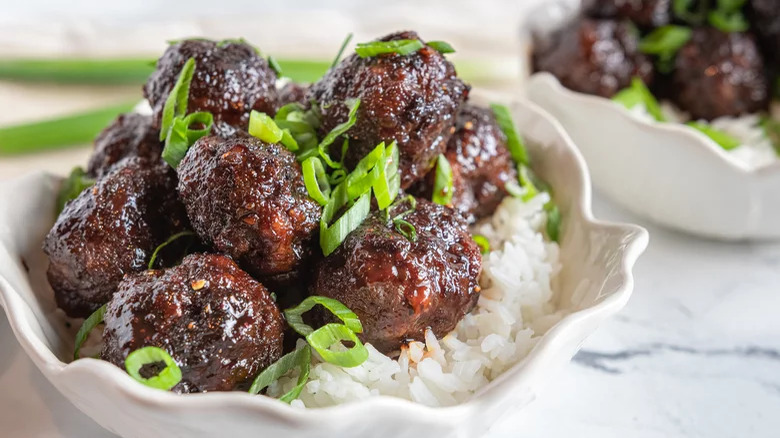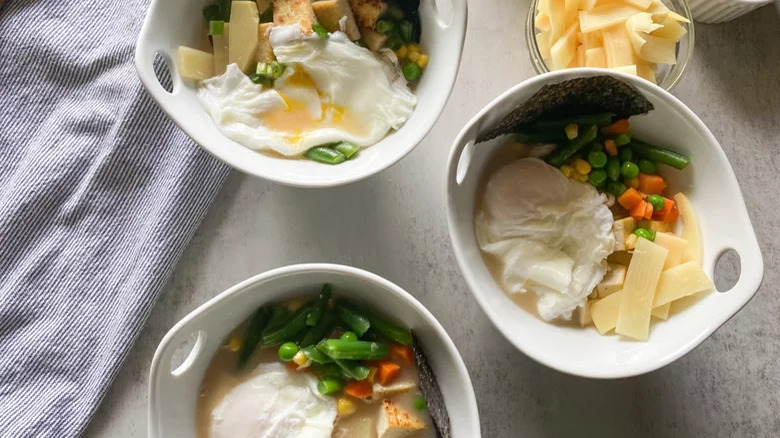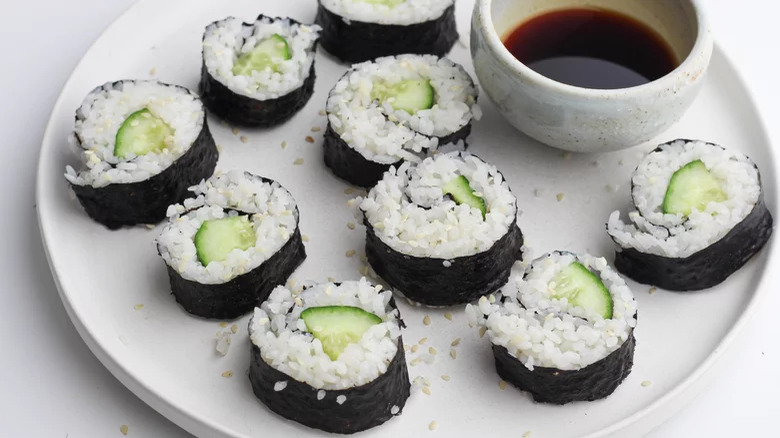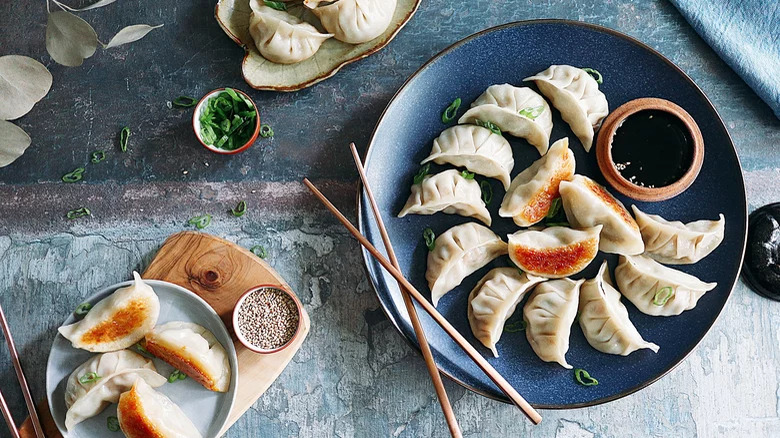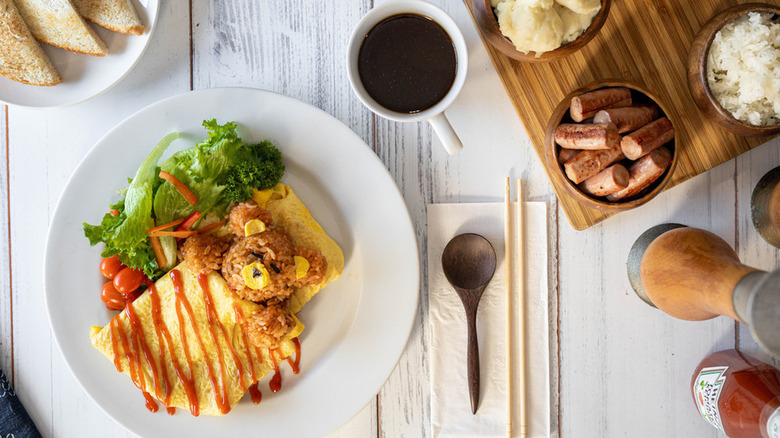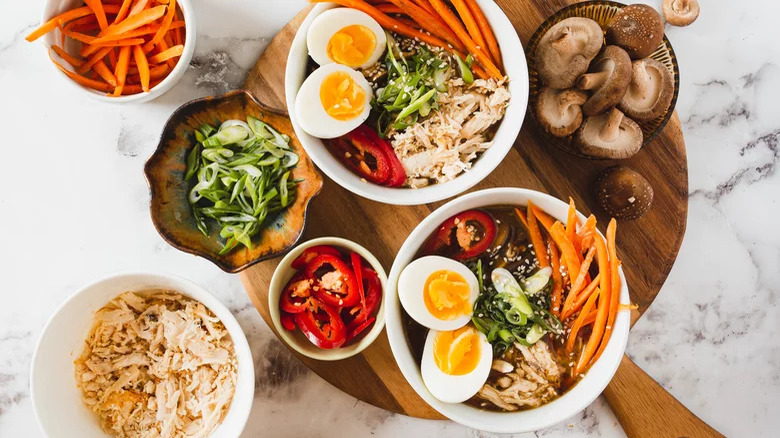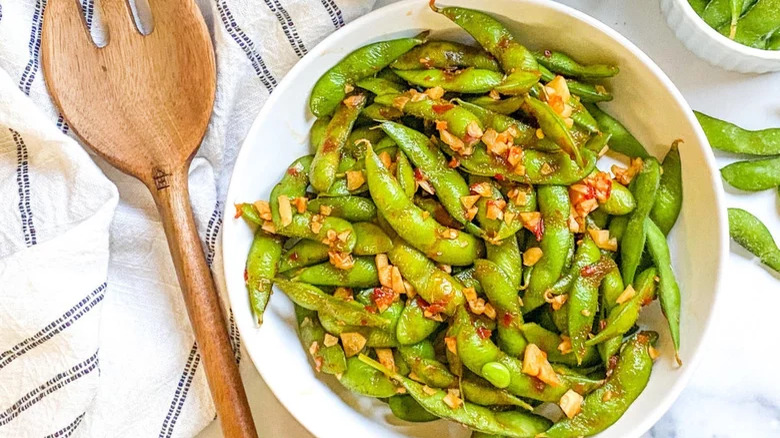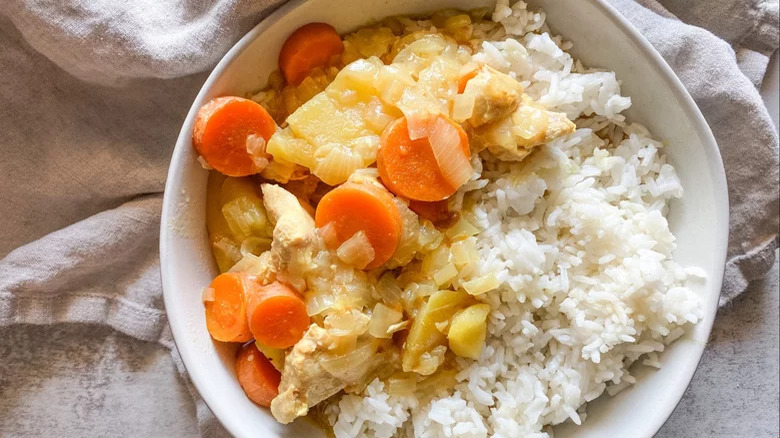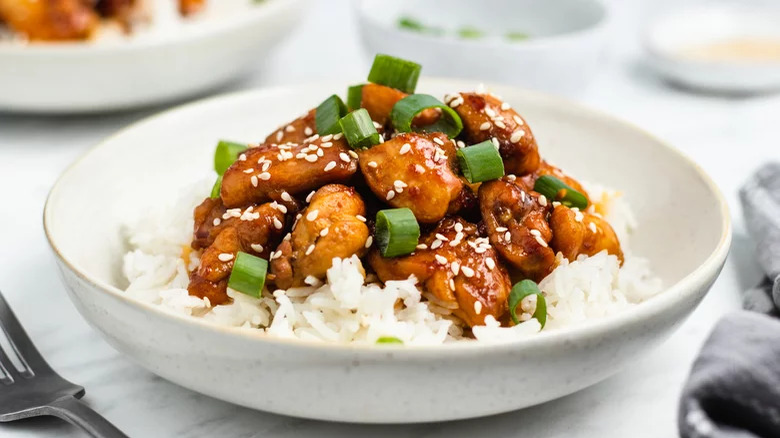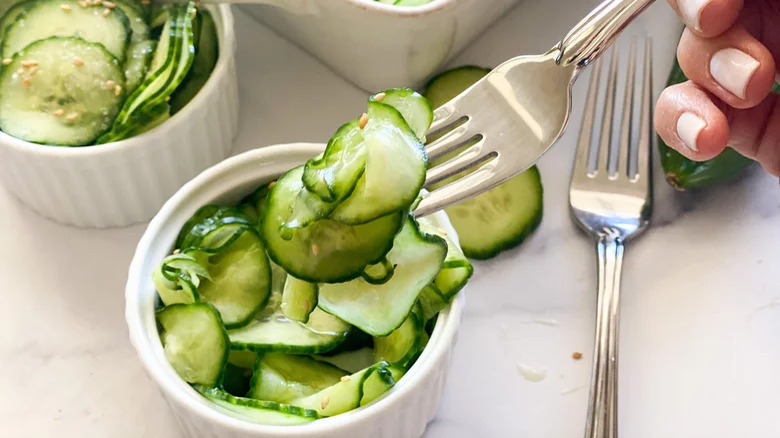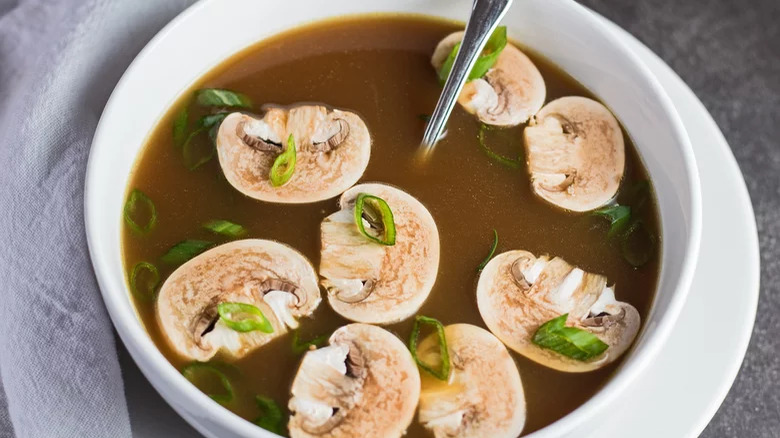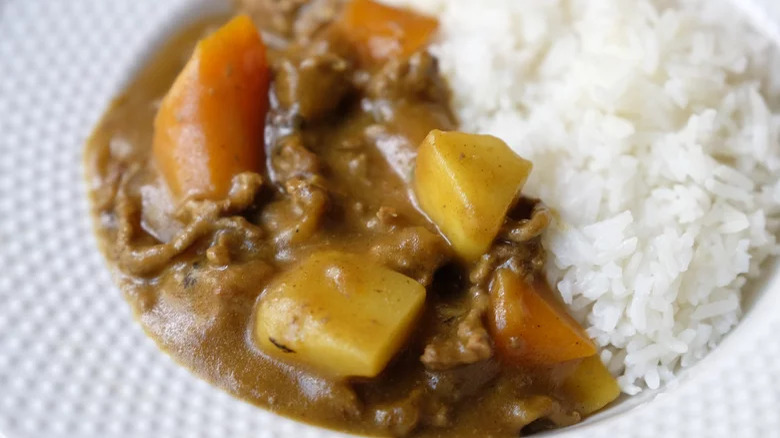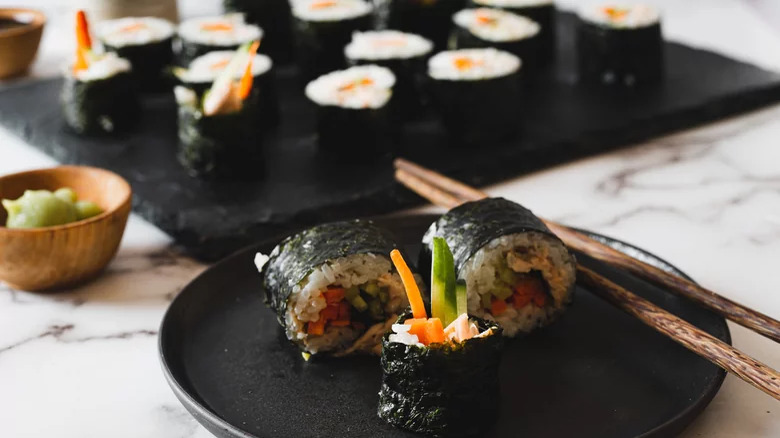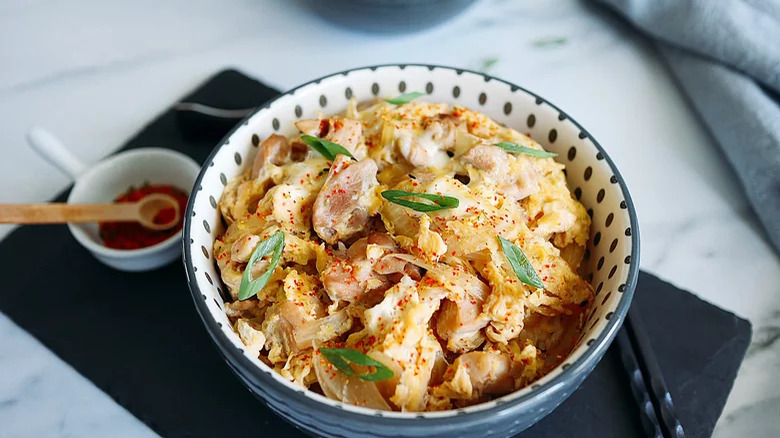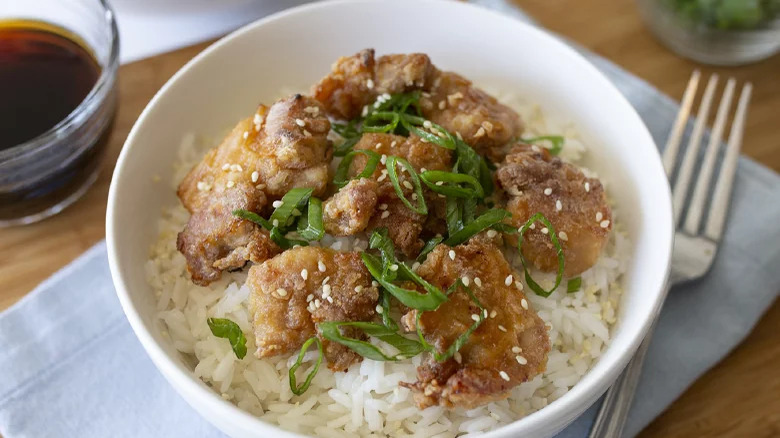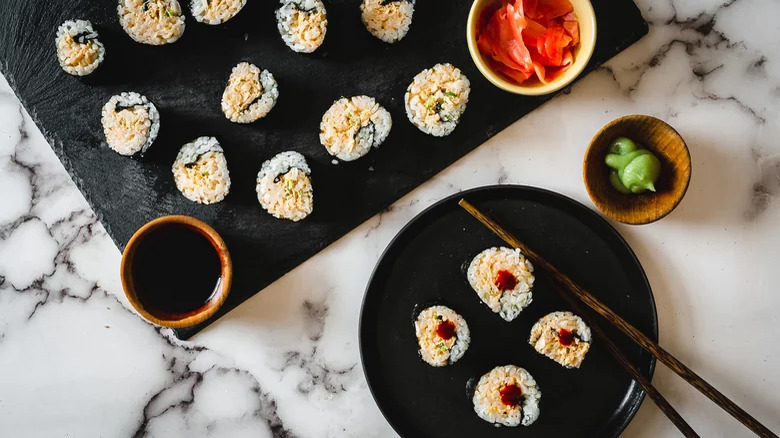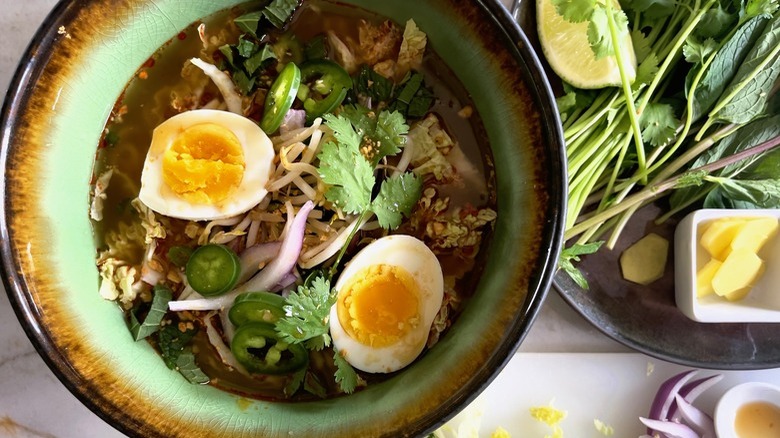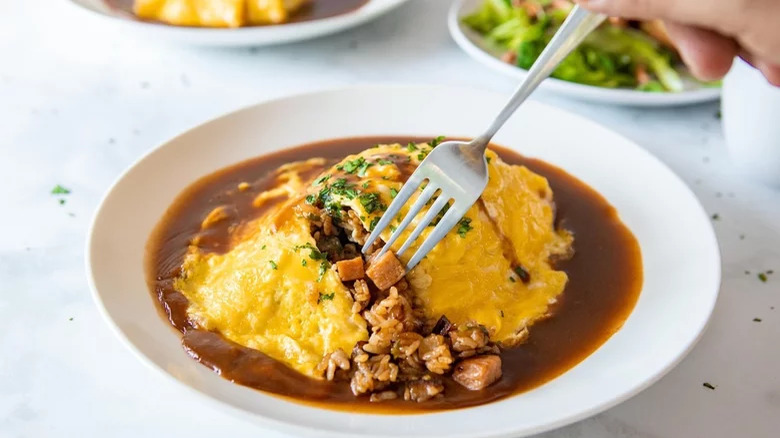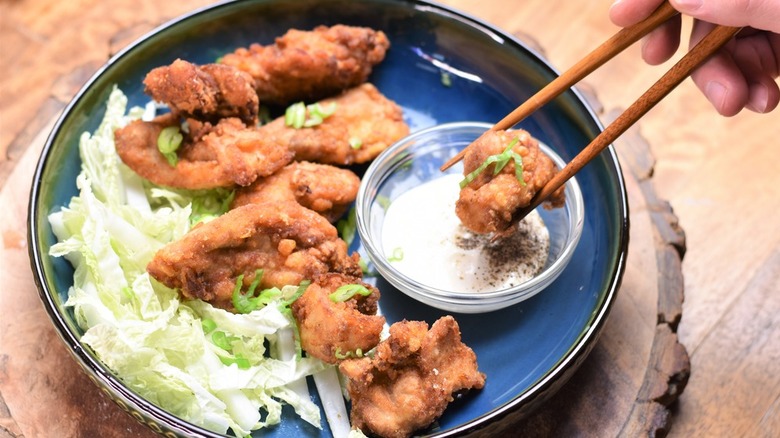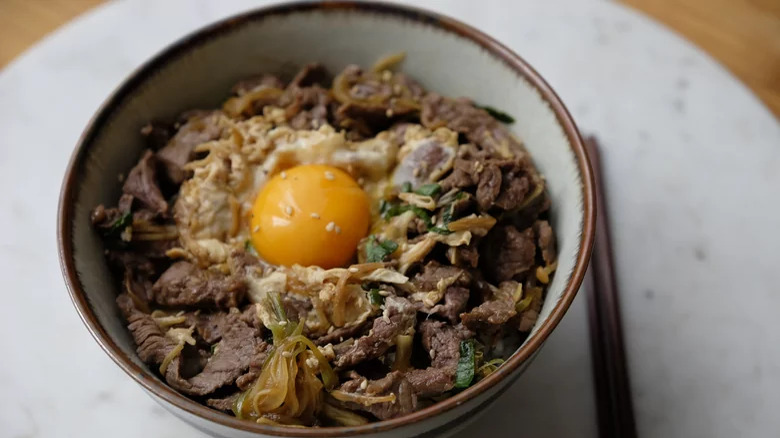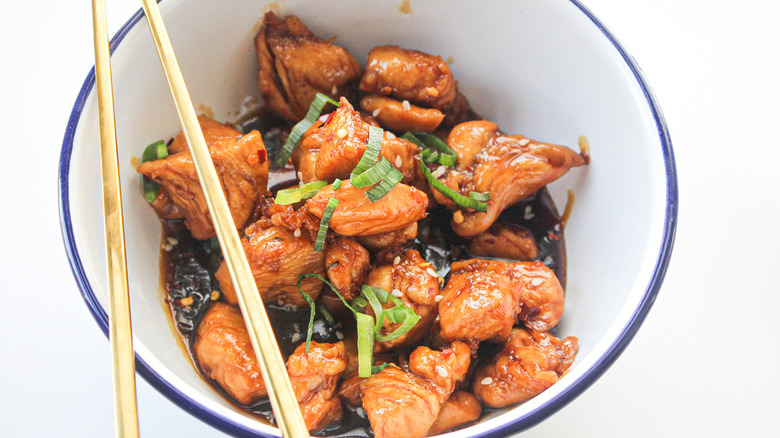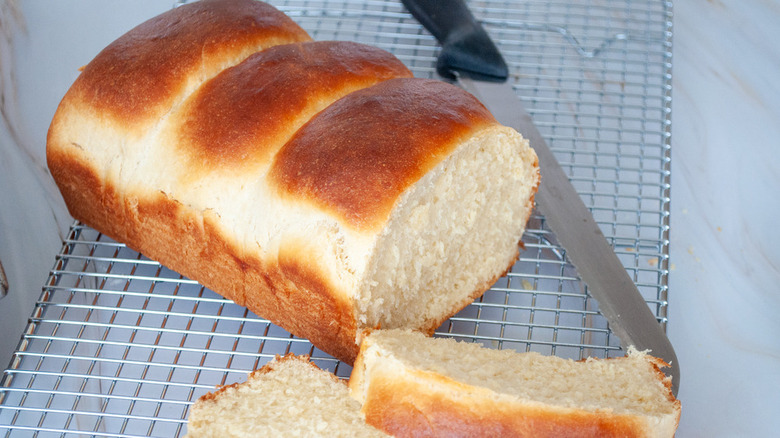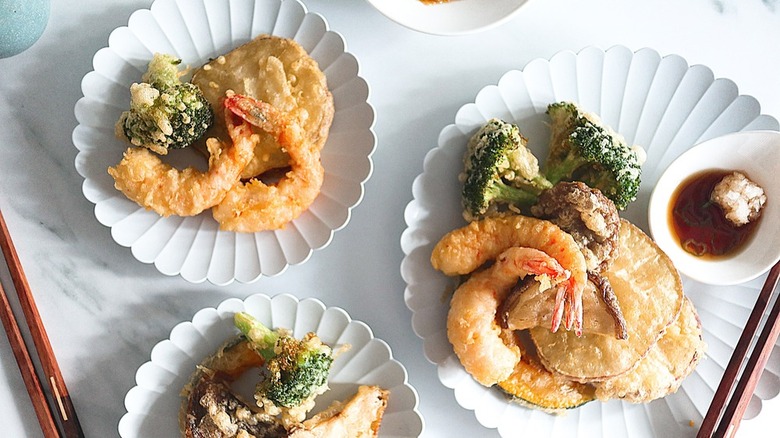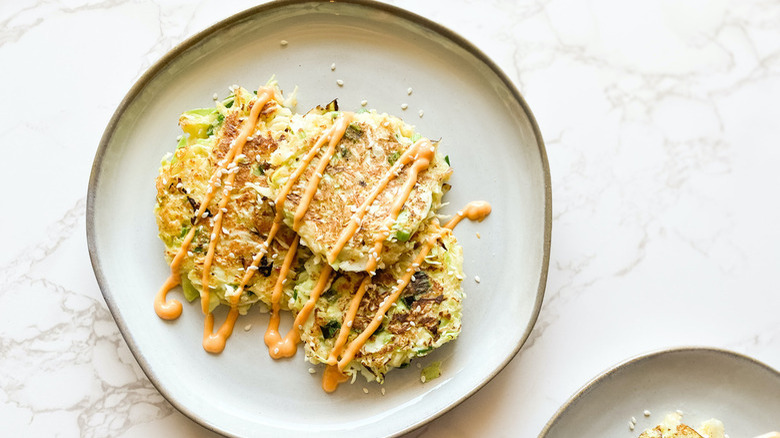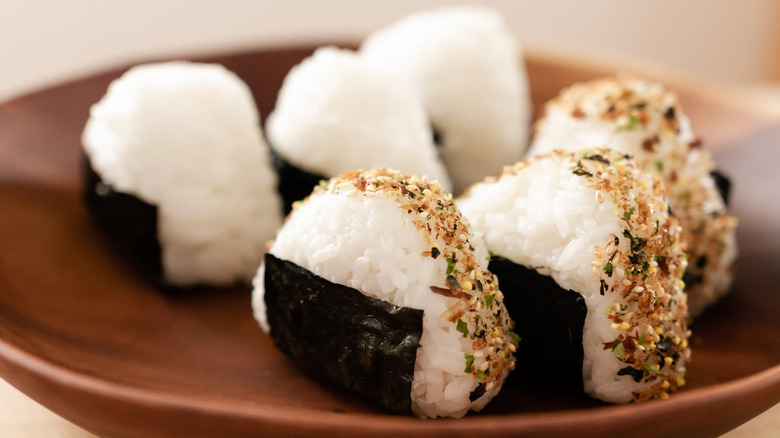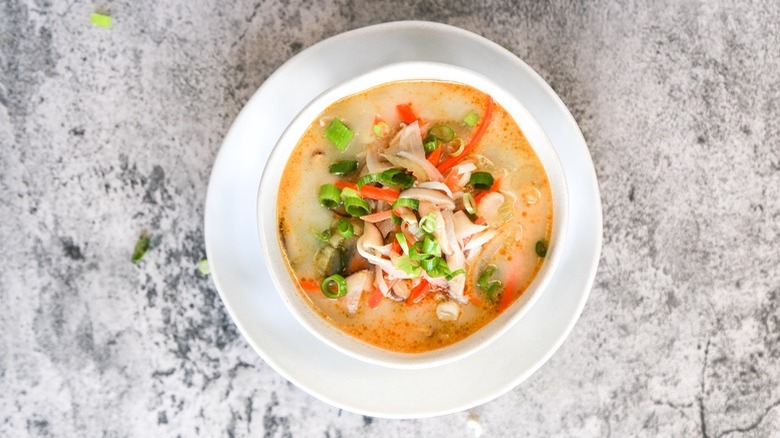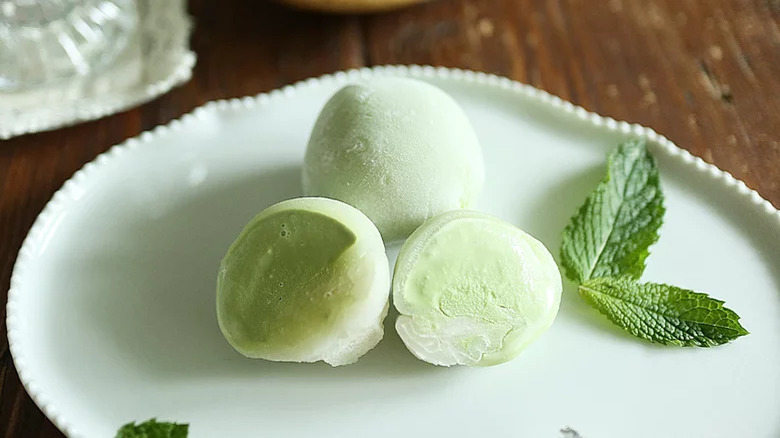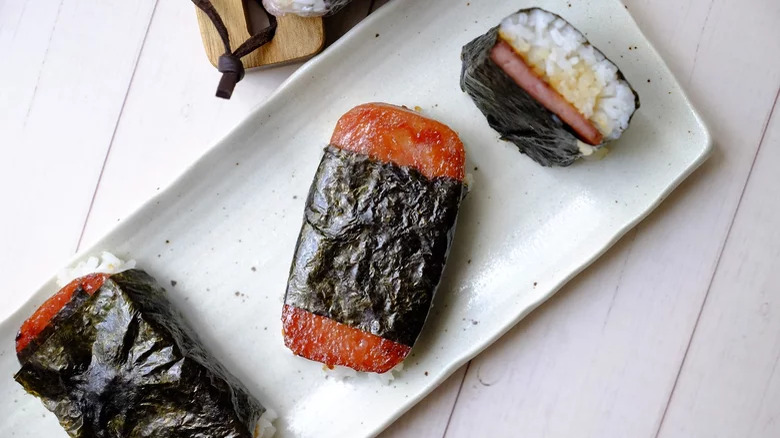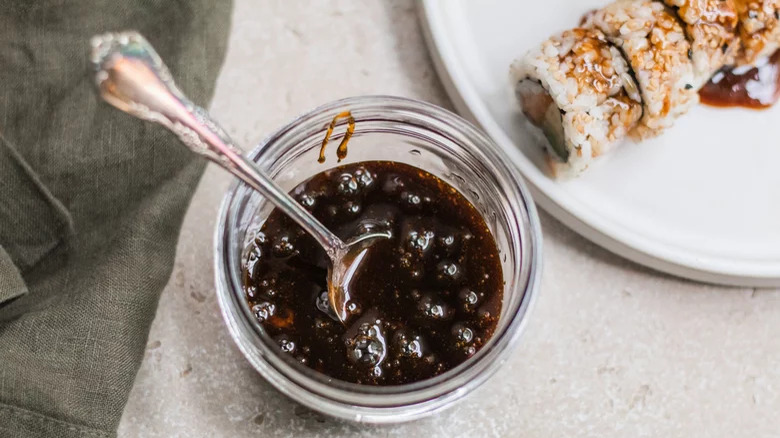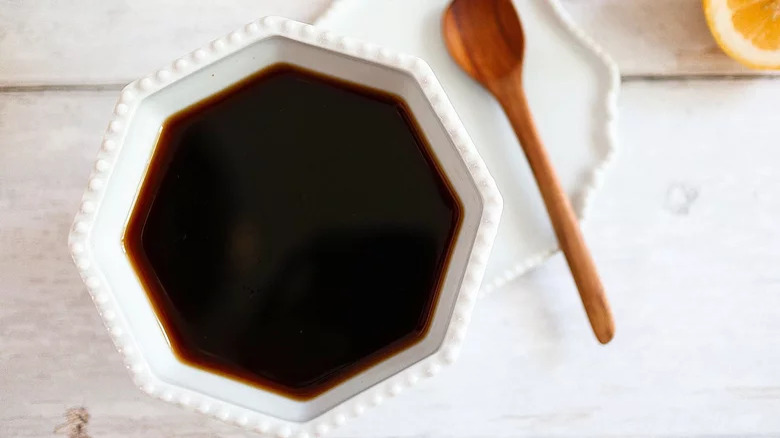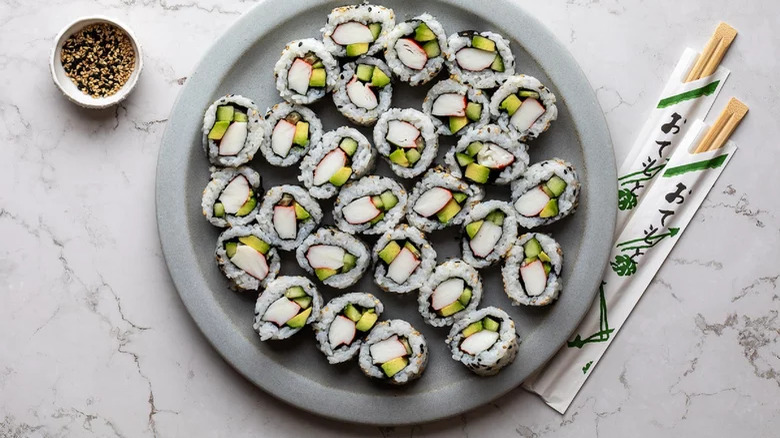35 Japanese Recipes To Try This Week
When pit against cuisines that have found a place on the dinner tables of most homes, Japanese food often falls behind Chinese, Italian, and Mexican food in popularity. It may be because there's a certain misconception about Japanese cuisine that makes it seem intricate, complex, and way too complicated to make at home. But it turns out, the cuisine's intricacy comes from its simplicity (per Kobe Teppanyaki).
Japanese cuisine focuses on using fresh ingredients that are in season and applies very little cooking to them so that their natural flavors do the heavy lifting. This means Japanese food can also be easy to make when you're in a pinch or when you've just been to a farmers' market and snagged a fresh basket of produce. All you need now are a few recipe ideas to get your cooking going.
From the usual suspects, such as ramen, sushi, and tempura, to Japanese curries and meals-in-a-bowl, here are a few Japanese recipes that you can easily add to your weekly meals. There are even a couple of classic sauces in here that will inspire you to give your regular recipes a Japanese twist.
1. Teriyaki Sauce
Teriyaki is a style of Japanese cooking where different kinds of meat and fish are marinated in a soy sauce glaze and then cooked or broiled. Once you nail the glace bit, you have a whole world of seasoned meats, seafood, and veggies waiting for you. This six-ingredient teriyaki sauce comes together in 20 minutes and can be stored for as long as three weeks. When it's time to get lunch or dinner going, consider pouring it into a stir-fry, giving your steamed veggies a boost of flavor, or going with a classic teriyaki chicken.
Recipe: Teriyaki Sauce
2. Donkatsu
Donkatsu gets its name from don, the Japanese word for pork, and katsu, a collective of Japanese comfort foods made from fried and breaded meat cutlets. While this recipe makes a classic donkatsu which is a popular street food in Japan, you can easily replace the pork with other meats and seafood to make different types of katsu. The key here is to make a perfectly crisp cutlet by dunking the pork in a three-step flour, egg, and breadcrumb dredge, and then frying the cutlets in oil that is heated to 340 F.
Recipe: Donkatsu
3. Smoked Salmon Sushi
If you think of sushi as food best left to restaurants and takeout, recipe developer Catherine Brookes' smoked salmon sushi will have you consider otherwise. Not only is making sushi easier than you think but it can also be prepped ahead of time and its fillings customized exactly to your liking. All you need is a pack of smoked salmon and avocados from the grocery store, your sushi rice mixture, and a few sheets of seaweed. Once you have your ingredients, Brookes guides you through the process of rolling them into fresh and bright sushi.
Recipe: Smoked Salmon Sushi
4. Teriyaki Meatballs
Up for giving your regular meatballs a Japanese-inspired spin? Although you'll be making both the meatballs and the teriyaki sauce from scratch, this recipe requires only 10 minutes of prep and come together in less than an hour. There is of course the option of using a store-bought teriyaki sauce but considering the fact the homemade version only needs you to whisk soy sauce, ginger, brown sugar, and honey together, it might just be easier to make the sauce from scratch. Serve it alongside some rice, noodles, or sautéed vegetables with a garnish of chopped scallions.
Recipe: Teriyaki Meatballs
5. David Chang's Momofuku Ramen Recipe With A Twist
You can't think of ramen without thinking of David Chang and his iconic Momofuku Noodle Bar which popularised ramen beyond its instant versions in America. So it's only fair that when you're in the mood to try the very definition of Japanese comfort food, aka ramen, you try a David Chang recipe. But where Chang's ramen is famous for its meaty pork, recipe developer Kristen Carli puts a vegetarian twist on it. Swapping the pork broth for a store-bought veggie one and the pork for stir-fried tofu, Carli's take on the ramen leaves out the meat but packs in just as much flavor.
6. Cucumber Roll
If you've ever thought Japanese food was frustratingly complicated, you're probably yet to meet recipe developer Susan Olayinka's cucumber rolls. All that Olayinka asks of you is a cucumber, sushi rice, nori sheets, salt, sugar, water, and ... well, that's it. Although the recipe requires a little under half an hour of your time, most of it goes into cooking the rice and slicing the cucumber. Once that's done, the cucumber rolls come together in a jiffy. Whether you serve them as a movie night snack, a cocktail party appetizer, a light lunch, or a full-blown dinner, don't forget to pair the rolls with sriracha, hoisin, or soy sauce for dipping.
Recipe: Cucumber Roll
7. Fried Pork Gyoza
Often confused with Chinese potstickers, gyozas are believed to be an invention of a Chinese practitioner who used them as an ailment for frostbite till the little pan-fried parcels were re-created by soldiers in Japan. Regardless of which country claims the right to call gyoza its own, one thing is certain: these fried pork gyozas are packed with so much flavor that they deserve a seat on your dinner table. While pinching your gyoza wrappers together may be intimidating at first, recipe developer Cecilia Ryu promises that you'll be a pro in no time. To make things easier however, she lists out ways to fix some of the most common gyoza wrapper problems if you run into any trouble.
Recipe: Fried Pork Gyoza
8. Omurice
While the United States is known to put an American spin on Asian food, Japan, too, likes to put a twist on Western classics. Known as yoshoku, or Western food with a Japanese twist, these dishes take American and European ingredients such as ketchup and the French demi-glace sauce and toss them into Japanese mains alongside soy sauce and rice. Omurice is one such yoshoku. A mix of omelet and rice, omurice is made from an omelet stuffed with chicken fried rice and topped with a generous drizzle of ketchup and demi-glace. This recipe also walks you through a creative way to assemble the rice and omelet like a sleeping teddy bear, making it a fun way to introduce kids to Japanese cuisine.
Recipe: Omurice
9. 30-Minute Chicken Ramen
Ramen features several components some of which take days worth of slow cooking before they're ready. The most arduous part is the broth. Not only does it take hours of simmering to make a broth, but it takes a whole multitude of ingredients and skill to build layers of flavors that will turn water into a stunning ramen-worthy broth. Most simply don't have that kind of time to spare on a single bowl of ramen. The solution? A 30-minute chicken ramen made from ingredients easily available at supermarkets and three kinds of store-bought broth — just because you're using a shortcut doesn't mean you have to compromise on the flavor.
Recipe: 30-Minute Chicken Ramen
10. Spicy Garlic Edamame
Most izakayas or pubs in Japan serve their sake with bar snacks known as otsumami (per All About Japan). And one of the most popular kinds of otsumami is edamame. While the edamame served in an izakaya is usually boiled and served with a pinch of salt, recipe developer Miriam Hahn has a punchier version of the snack for you to serve alongside a chilled beer or two. Tossed in a spicy chili paste, soy sauce, sesame oil, and minced garlic mix, the garlic edamame doubles up as a spicy and healthy snack for pretty much any time of the day.
Recipe: Spicy Garlic Edamame
11. Instant Pot Japanese Curry
You may be familiar with coconut-laced Thai curries or the spicy ones synonymous with Indian cuisine, but you don't particularly think of Japan as a cuisine that features curries. But curry is quite the popular dish in Japan and is even regarded to be part of the country's many national dishes. Sweeter and milder than the fiery Indian curry, the Japanese version is made with simple ingredients, spices, and a rich sauce. The thick curry is best served with rice that will soak up the rich and flavorful liquid.
Recipe: Instant Pot Japanese Curry
12. Teriyaki Chicken
You could say that teriyaki chicken is a Japanese-inspired dish that is entirely American in origin but there's no denying that both the sauce and its many preparations have quite the following in Japan as well (per Chard Kitchen). It also helps that this particular recipe requires only five minutes of prep and another 12 minutes of cooking for enough teriyaki chicken for three servings. While chicken is the protein of choice in this teriyaki dish, you can easily swap it with shrimp, pork, or even a block of tofu for a plant-based alternative.
Recipe: Teriyaki Chicken
13. Sunomono
Often labeled as cucumber salad on Japanese restaurant menus, sunomono is a type of salad popular in Japanese cuisine that is made from cucumbers and a type of seaweed known as wakame. Considering that the most arduous bit about making the salad is chopping the cucumbers into delicate slices, sunomono is an easy salad to put together, especially if you have a mandolin to make things easier. From there, all you need is some soy sauce, rice vinegar, salt, and sugar to make the tangy sunomono sauce for the dressing.
Recipe: Sunomono
14. Japanese Clear Soup
Japanese clear soup is most often served as the first dish at hibachi restaurants before a whole train of food cooked on the open grill follows. While you don't need to own a hibachi grill to make this soup, recipe developer Angela Latimer does ask that you follow her "instructions to a T" to replicate the clear soup's flavors at home. The trick to nailing the flavors Latimer says, is to prepare the soup in advance and give the flavors some time to infuse into the liquid — preferably a day's time in the refrigerator. Besides, while the recipe takes well over an hour, most of the time goes into the soup simmering away on the stove. All you need is five minutes of undivided attention to get the prep going.
Recipe: Japanese Clear Soup
15. Beef Curry
There are two secret ingredients in this Japanese beef curry: Golden Curry roux blocks and apples. An important staple in Japanese pantries, Golden Curry roux is made from a mix of flour, fat, seasonings, and curry powder which has been turned into a roux, cooled into blocks, and sold at grocery stores. Besides the cubed roux, sliced apples are what give the Japanese curry its distinctively sweet flavor. Although this recipe uses beef patties as the protein, you have the option of swapping it with tofu for a plant-based alternative. You can even leave the protein out entirely and beef the curry up with a ton of vegetables instead.
Recipe: Beef Curry
16. Baked Salmon Sushi
If you're not one for the raw seafood that typically goes into the making of sushi, this baked salmon sushi will be an easy winner. As the name suggests, the sushi is made from a filling of flaked salmon baked in the oven. While the salmon is cooked, the vegetables that go along with it are left raw. Thin strips of carrot and cucumber add a crunch, avocado slices lend a creamy texture, and the sriracha laced mayo on top brings heat that compliments the fresh and bright flavors of the vegetables and the protein.
Recipe: Baked Salmon Sushi
17. Oyakodon Bowl
Japan is famous for its donburi, also known as rice bowls. Of all the donburi options, oyakodon is one of the most popular bowls of its kind (per Just One Cookbook). Oyakodon translates to parent and child rice bowl and gets its name from the two starring components in it: chicken (the parent) and egg (the child). Besides the two ingredients, this oyakodon recipe also calls for a whole array of Japanese ingredients, such as dashi stock powder, mirin, soy sauce, sake, mirin, and a dried blend of peppers known as shichimi togarashi. Once you have the ingredients, all the oyakodon cooking happens in one pot, leaving little cleaning for after.
Recipe: Oyakodon Bowl
18. Mochiko Chicken
If you like meals that can be prepped in advance and involve a fair bit of chicken, this beginner-friendly baked mochiko chicken may be just the meal for you to try next. Most of the prep time for the mochiko chicken goes into marinating the meat in a soy sauce, mirin, garlic, and ginger sauce for four hours. Once the liquid has infused into the chicken, all you need to do is coat the protein in a mochiko mixture, or sweet rice flour, and let it bake in the oven. Sprinkle some sesame seeds and spring onions on top, and serve the chicken over a mountain of rice.
Recipe: Mochiko Chicken
19. Spicy Tuna Sushi Roll
Sushi most often highlights the flavors of raw fish, all of which can be incredibly subtle and sophisticated. While this makes the popular Japanese dish incredibly nuanced, sometimes you just want a bit of spice. If you like your sushi with a touch of sriracha hiding in it, this spicy tuna sushi roll is just the thing for ya. The sushi gets its spice from a sriracha mayo mix that's folded into canned tuna along with some sesame oil, diced scallions, and rice vinegar. If you want to take things up a notch, you can bring even more heat by adding a dollop of sriracha onto the sushi once it's sliced.
Recipe: Spicy Tuna Sushi Roll
20. Ramen
If you've ever slurped on a fresh bowl of ramen at a restaurant, you know that the packets of instant ramen noodles are nowhere close to the real deal. Dubbed as "a complete meal in a bowl" by recipe developer Tricia Wheeler, a traditional bowl of ramen may require a fairly long list of ingredients, but that's where the complexity ends. Once you've gotten the hang of making the broth and assembling the many components of a ramen bowl on top, you can customize the Japanese classic. More spice? Fewer vegetables? Different noodles? The whole world is your oyster.
Recipe: Ramen
21. JunsKitchen's Omurice
A type of yoshoku, omurice is a mix of omelet and rice where a fluffy omelet is covered in a demi-glace sauce or ketchup and topped over a mountain of fried rice. A take on popular YouTube channel JunsKitchen's omurice which went viral a few years ago, recipe developer Keith Kamikawa's recipe is perfectly portioned to serve one person. The main difference here is that while JunsKitchen uses chicken, Kamikawa's recipe pays tribute to the history of Spam in Japan and so, uses Spam and red potatoes in its place.
Recipe: JunsKitchen's Omurice
22. Karaage
It's unlikely that anyone could ever get bored of fried chicken, especially if you consider the fact that there's an entirely different way to prepare it. Japan has a version of fried chicken known as karaage. Made from boneless chicken thighs, karaage requires that you coat your chicken in a rice flour and cornstarch mixture, which makes the Japanese fried chicken far lighter than the kind made from wheat flour. The coating aside, you'll also find other Japanese flavors in karaage as the chicken is marinated with ginger, garlic, soy sauce, and dry sherry. But that's not all: This recipe also includes a dipping sauce made from Japanese mayo Kewpie to accompany the fried chicken.
Recipe: Karaage
23. Better Than Takeout Beef Donburi
Toss the takeout menu aside for another day. Recipe developer Eric Ngo has a 30-minute beef donburi recipe that will be just as good, if not better than the takeout from your neighborhood Japanese eatery. Technically known as gyudon because the donburi is made with beef, Ngo uses thin slices of sirloin steak in the recipe. Besides the sirloin, you'll also need rice — preferably Japanese rice — as well as certain Japanese staples, such as mirin, sake, dashi, and soy sauce. Topped with a bright egg yolk, the beef donburi is garnished with green onion, black pepper, and sesame seeds, and is best eaten hot off the pan.
Recipe: Better Than Takeout Beef Donburi
24. 3-Ingredient Teriyaki Chicken
Chicken Teriyaki is simple enough as it is, but recipe developer Susan Olayinka has broken it down into a dish so easy that it can be prepared every day of the week. Traditionally, the teriyaki sauce that coats the chicken is made from three ingredients: sugar, soy sauce, and sake. But according to Olayinka, the sweet and salty flavor of the sauce can be closely replicated with soy sauce and sugar alone. This is why, her recipe uses nothing more than soy sauce, sugar, and chicken to make a three-ingredient teriyaki chicken. If you do have more time and ingredients to spare, you can top the chicken with green onions and sesame seeds, sriracha, and red pepper flakes, or serve it with rice, noodles, or veggies for a complete meal.
Recipe: 3-Ingredient Teriyaki Chicken
25. Milk Bread
Milk bread, or shokupan as it often goes by in Japan, requires a fairly common ingredient list that you'd expect from any bread but gives in return a soft and light bread that is as fluffy as a cloud. Even better, this milk bread only needs 25 minutes of hands-on time as the rest goes into waiting for the dough to rise and bake in the oven. Once it's baked, you can slice the milk bread into thick slabs and serve it alongside omelets, soups, and salads or go the more traditional route and use it to make dessert sandos with thick layers of fruit and cream or turn it into the Japanese French toast known as shibuya, honey, or brick toast.
Recipe: Milk Bread
26. Tempura
Who doesn't like deep-fried food? If you've worked your way through Southern fried chicken and Indian pakoras, Japan's famed tempura should be the next deep-fried dish you try. Tempura has a reputation for being incredibly light, crisp, and airy, the secret for which recipe developer Cecilia Ryu says is to make sure that the tempura batter is cold when it hits the hot oil. Although making tempura may be a slightly daunting task at first, Ryu assures that as long as you have all the ingredients and follow the instructions carefully, you'll be on your way to conquering the world of tempura.
Recipe: Tempura
27. Okonomiyaki
Often dubbed as the Japanese pancake or the Japanese pizza, okonomiyaki gets its name from okonomi, the word for what you like, and yaki meaning grilled. Essentially then, okonomiyaki is a dish made from whatever you like, cooked on a grill. While this recipe uses cabbage, eggs, and panko breadcrumbs to make the okonomiyaki, true to its name, you can customize the ingredients to your liking. It's also up to you how you eat the Japanese pancake: Sprinkled with green onions and dried bonito flakes is a popular option, hoisin or sriracha mayo are ideal if you like your pancake saucy, and Kewpie mayonnaise is ideal if you'd like your topping to be as Japanese as the pancake.
Recipe: Okonomiyaki
28. Onigiri
Onigiri, though simple in appearance, is an extremely elegant dish. Eaten as a snack, a side dish, or as an entire lunch in itself, onigiri is made from rice that is stuffed and shaped into balls or triangles and wrapped in a sheet of nori. This recipe uses fresh salmon and umeboshi or salted plum as the stuffing for onigiri but you swap it with chicken, shrimp, or all kinds of vegetables. From there on, this recipe gives you tips to get the rice just right, shows you the way to shape your rice, and even guides you through the proper way to cut the sheets of nori into little strips.
Recipe: Onigiri
29. Miso Soup
If there's one dish on par with sushi and ramen in popularity when it comes to Japanese foods, it's most likely to be miso soup. And much like any other soup that you easily replicate in your kitchen, miso soup too can be made at home. While recipe developer Maren Epstein says that there's nothing particularly difficult about miso soup per se, its lengthy ingredient list may be the most strenuous bit. Easy to find vegetables and aromatics aside, you'll also need kombu leaf and three varieties of miso paste: mellow white, red, and yellow. There are also ingredients such as bonito flakes, tofu, and dashi to consider. Though not necessary in the recipe, they add enough to the soup to warrant a shopping trip to a specialty store.
Recipe: Miso Soup
30. Ice Cream Mochi
Mochi is a Japanese dessert so popular in the United States that even the likes of Costco have started to stock big boxes of these chewy balls made from sweet rice flour. But there's one important advantage about making homemade ice cream mochi, says recipe developer Cecilia Ryu: "You can make it with your ice cream of choice." While the mochi is made from mochiko, powdered sugar, salt, and cornstarch, the ice cream filling inside is entirely up to you. Regardless of the flavor you choose, Ryu's only advice is to work fast; ice cream melts much faster than you think.
Recipe: Ice Cream Mochi
31. Spam Musubi
Whether or not Spam musubi can be called a Japanese food is a matter of debate but its origin is largely credited to Japanese workers of the 19th century who lived in Hawaii. Although it was invented in Hawaii, Spam musubi was inspired by the Japanese rice balls called omusubi, also known as onigiri. Now, Spam musubi is just as popular in Japan as it is in Hawaii. Similar to onigiri in that it's a handheld dish, Spam musubi is typically served at breakfast or as a snack. This Spam musubi recipe is a classic one and relies on just a few ingredients. All you need is a can of Spam, a cup of cooked rice, a couple of nori sheets, and a few tablespoons of teriyaki sauce.
Recipe: Spam Musubi
32. Eel Sauce
If reading the words eel sauce makes you think that eels went into the making of this Japanese sauce, you're in for a lovely surprise. Similar to hoisin or teriyaki sauce, eel sauce is made from thickened soy sauce and has a more sweet and salty flavor than the strong, molasses-like taste of hoisin. All that the sauce needs is some sugar, soy sauce or tamari, and mirin. You also have the option of swapping some of the mirin with sake. So, why is it called eel sauce, you ask? Because the sauce is meant to be spread over grilled eels, of course. But if eels aren't your thing however, you can also serve it alongside some sushi or pour it onto meats, veggies, and rice bowls.
Recipe: Eel Sauce
33. Japanese Whisky Highball
Japanese cuisine is famously known for simple ingredients and deep flavors. This it turns out, is not limited to merely Japanese food. According to recipe developer Michelle McGlinn, the Japanese whisky highball may look like a simple mixed drink but has an incredible depth of flavor. The Japanese whisky — Suntory in this case — adds "a very light, sweet, almost caramel flavor," and the ginger ale is "refreshing but full of depth." Finished off with a smoky flavor from a flaming lemon peel, the three-ingredient cocktail is fun, easy, and packed with layers of flavor.
Recipe: Japanese Whisky Highball
34. Ponzu Sauce
While the typical ponzu sauce relies on yuzu lemons that are common in Japan and Korea for its citrusy tang, recipe developer Cecilia Ryu has a couple of tricks for you to swap the yuzu with easy-to-find ingredients when you're making the sauce at home. (Meyer lemons have a fragrance similar to yuzu, so that's an obvious alternative.) If not Meyer lemons, Ryu recommends going with a half-and-half mixture of juices from lemons and mandarin oranges or a mix of lemon and lime juices. Once you've gotten that out of the way and grabbed some soy sauce, mirin, kombu, and bonito flakes, you're on your way to making homemade ponzu sauce in under 15 minutes.
Recipe: Ponzu Sauce
35. California Roll
California roll was invented by a Japanese sushi chef by the name of Hidekazu Tojo in Canada. Looking for ways to give his Canadian neighbors a taste of Japan without the raw fish that they found stinky, Tojo replaced the fish with avocado and crab meat, and added mayonnaise for a little bit of oomph. Much like the original California roll, this recipe relies on surimi (imitation crab), avocado, and seedless cucumbers for the filling. In true California roll-style, the nori sheet also goes inside the rice in this easy-peasy sushi.
Recipe: California Roll
